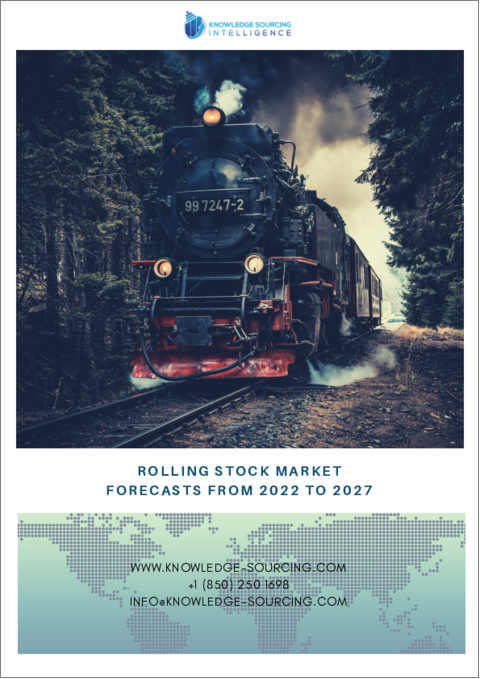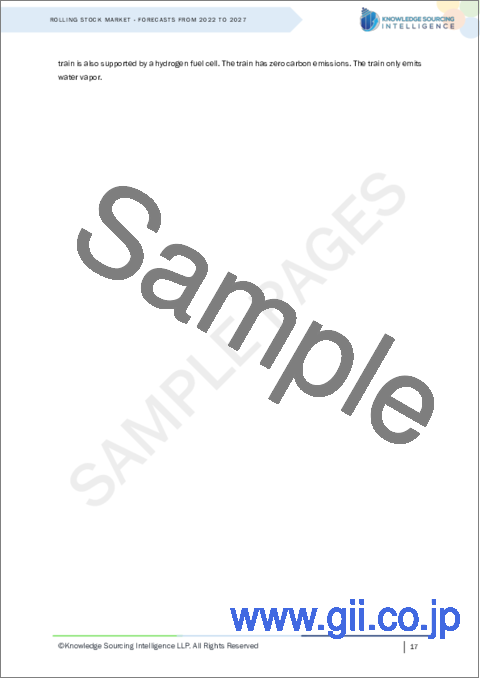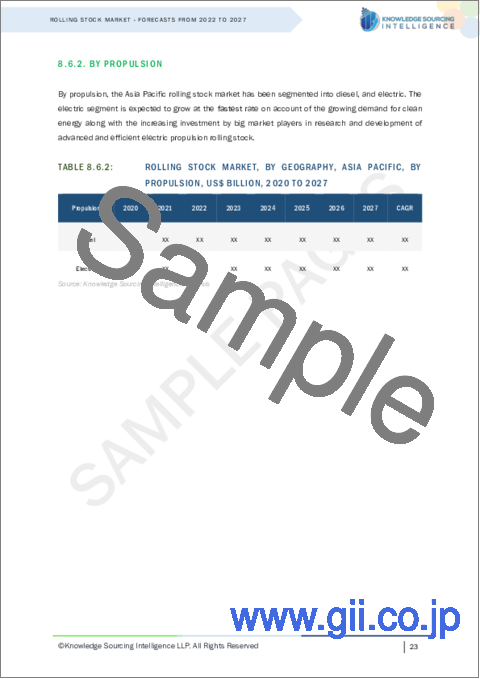|
|
市場調査レポート
商品コード
1148360
鉄道車両の世界市場:2022年~2027年Rolling Stock Market - Forecasts from 2022 to 2027 |
||||||
|
● お客様のご希望に応じて、既存データの加工や未掲載情報(例:国別セグメント)の追加などの対応が可能です。 詳細はお問い合わせください。 |
|||||||
| 鉄道車両の世界市場:2022年~2027年 |
|
出版日: 2022年09月13日
発行: Knowledge Sourcing Intelligence
ページ情報: 英文 142 Pages
納期: 即日から翌営業日
|
- 全表示
- 概要
- 目次
世界の鉄道車両の市場規模は、2020年の594億2,400万米ドルから、4.07%のCAGRで推移し、2027年には785億6,000万米ドルの規模に成長すると予測されています。
今後5年間における市場成長の要因は、鉄道車両の増強や、遠隔地と都市部を結ぶ鉄道網の拡張への各国政府による投資が急増していることです。これにより、鉄道車両の需要が促進され、予測期間を通じて市場成長が著しく促進されると予想されています。
当レポートでは、世界の鉄道車両の市場を調査し、市場概要、市場成長への各種影響因子の分析、市場規模の推移・予測、各種区分・地域/主要国別の内訳、競合環境、主要企業のプロファイルなどをまとめています。
目次
第1章 イントロダクション
第2章 調査手法
第3章 エグゼクティブサマリー
第4章 市場力学
- 市場促進要因
- 市場抑制要因
- ポーターのファイブフォース分析
- 産業バリューチェーン分析
第5章 鉄道車両市場の分析:タイプ別
- 機関車
- 高速列車
- 快速列車
- コーチ
- その他
第6章 鉄道車両市場の分析:推進力別
- ディーゼル
- 電気
第7章 鉄道車両市場の分析:用途別
- 旅客輸送
- 貨物輸送
第8章 鉄道車両市場の分析:地域別
- 北米
- 南米
- 欧州
- 中東・アフリカ
- アジア太平洋
第9章 競合環境・分析
- 主要企業・戦略分析
- 新興企業・市場の収益性
- M&A・契約・提携
- ベンダーの競合マトリックス
第10章 企業プロファイル
- CRRC Corporation Limited
- Alstom
- HYUNDAI ROTEM COMPANY
- Wabtec Corporation
- Mitsubishi Electric Corporation
- Kawasaki Heavy Industries, Ltd.
- Hitachi, Ltd.
- The Greenbrier Companies
- Siemens
- Niigata Transys Co., Ltd.
The rolling stock market is projected to grow at a CAGR of 4.07%, from US$59.424 billion in 2020 to US$78.560 billion in 2027.
Rolling stock refers to all the types of vehicles operating in the rail transport industry, including locomotives, coaches, and wagons, among others. The factors that drive the rolling stock market growth in the next five years are the burgeoning investments by the governments of various countries around the globe in the expansion of railway fleets and the expansion of railway networks to connect remote areas with urban areas. This, in turn, is anticipated to propel the demand for rolling stock and drive market growth significantly throughout the forecast period.
The demand for public transport is increasing significantly, especially rail transport, due to lower costs and the wide presence of rail networks in almost every country worldwide.
According to the International Energy Agency, freight activity and the number of passengers are expected to double by the year 2050. This will further drive the demand for energy and lead to increased carbon emissions, and further put impact the environment. This, in turn, has led to increased focus of the governments of numerous countries towards the protection of the environment, which is leading to the growth in the investments of electric rail systems with an aim to curb the carbon emissions is further projected to impact the market growth positively in the near future. For instance, the government of India is planning to electrify the entire railway network of the country by the year 2025 to save energy worth US$1.5 billion.
However, the primary factor that inhibits the market growth is the long-life span of these rolling stocks, as high initial costs further lead to overhaul and refurbishment of current stock, which is anticipated to be a prime factor to moderately impact the market growth in the coming year. Also, the recent pandemic of the deadly COVID-19 is anticipated to hamper the demand owing to the halt in railway operations in many countries along with the temporary closure of industries which has led to a standstill in manufacturing activities, thereby negatively impacting the growth in the short run.
Rising investments in the railway sector
The key factor driving the rolling stock market growth during the forecast period is the growing investments in the railway sector of the various developing and developed economies of the world in the form of infrastructural expansions, fleet expansions, and the expansion of rail networks. All these factors collectively contribute to the increased demand for various types of rolling stock and further bolster market growth. Also, the railway sector in many countries is considered one of the most important revenue generation sectors, which is also a prime factor for the growing investments for tapping the potential revenue growth opportunities by the government. The infrastructure investments in rail transport in the various developing economies in the expansion of new railway networks and enhancement of current in developing economies play a significant role in boosting the market growth. In India, the investment of rail infrastructure reached 10,368,632,929 Euros by 2017 from 5,149,561,183 Euros in 2010. Also, the government schemes for the penetration of bullet trains in the country are anticipated to provide an impetus for the market to surge in the next five years. For instance, in June 2015, India and Japan agreed on developing a new high-speed railway network connecting Ahmedabad and Mumbai. The project is expected to come into operation by 2023. Similarly, in China investment increased to 105,084,000,000 Euros by 2017 from 85,005,375,986 Euros in 2010. Furthermore, in December 2018, Renfe, Spain's state-owned company that operates freight and passenger trains in the country, announced its plan to expand its railway fleet by acquiring new trains with a budget allocation of 3 billion Euros. All these factors are anticipated to propel the rolling stock market growth during the next five years.
Asia Pacific region is anticipated to occupy a notable share.
Geographically, the rolling stock market is segmented into Europe, North America, South America, the Asia Pacific, the Middle East and Africa. The Asia Pacific region is anticipated to occupy a significant share of the global market. The growth could be attributed to the presence of one of the largest and most well-established rail networks in countries like China, India, and Japan. Additionally, the growing investments in India in electric trains, metros, and bullet trains are further supplementing the market growth in the APAC region during the next five years. The North American region is anticipated to show notable growth throughout the forecast period owing to the well-established state-of-the-art railway infrastructure and key market players in the region.
Key Developments
- In June 2022, Indian Railways launched the 'Bharat Guarav' scheme in the Southern Railway. The objective of this launch is to portray the country's rich cultural heritage and historical places. This train would be operated by the private operator, South Star Rail.
- In May 2022, DFDS, a Danish multinational logistics conglomerate, acquired primeRail, a German rail operator. This acquisition consolidates DFDS' rail offerings as it seeks sustainable solutions to continue offering valuable and reliable services.
- In March 2022, Memphis Area Transmit in the US launched a new rail car, the U2 light rail vehicle.
- In January 2020, Bombardier announced the signing of its contract with China State Railway Group Co., Ltd. for the supply of 160 new high-speed train cars.
- In June 2019, Bombardier announced the expansion of its facility in California by opening a new rail car assembly site.
- In December 2019, CRRC Corporation Limited announced its contract to supply 26 light rail vehicles to the Monterrey Metro Bureau, Mexico.
- In December 2018, Ukrainian Railways announced its agreement with GE Transportation to expand the country's rail fleet to accelerate revenues.
- In November 2018, the Moldovan Railways (CFM)appointed GE Transportation for the supply of locomotives and their services.
COVID-19 Impact:
COVID-19 had a negative impact on the global rolling market. The rapid spread of the virus across the globe caused multiple governments to enforce drastic measures such as complete lockdown and social distancing. Furthermore, border restrictions were also enforced, strictly restricting travel across the countries, states, and provinces. Consequently, services of many rails were also stopped, negatively affecting the rolling stock market.
Competitive Insights
Prominent key market players in the rolling stock market include Siemens, Bombardier, HYUNDAI ROTEM COMPANY, Wabtec Corporation, Mitsubishi Electric Corporation, Kawasaki Heavy Industries, Ltd., and Hitachi, Ltd, among others. These companies hold a noteworthy share in the market on account of their good brand image and Type offerings.
Major players in the rolling stock market have been covered along with their relative competitive position and strategies. The report also covers the recent strategic deals and investments deployed by several prominent market players over the past few years.
Segmentation
- By Type
Locomotives
High-Speed Trains
Rapid Transit Trains
Coaches
Others
- By Propulsion
Diesel
Electric
- By Application
Passenger Transport
Freight Transport
- By Geography
North America
- USA
- Canada
- Mexico
South America
- Brazil
- Argentina
- Others
Europe
- Germany
- France
- United Kingdom
- Spain
- Others
Middle East and Africa
- Saudi Arabia
- Israel
- Others
Asia Pacific
- China
- Japan
- South Korea
- India
- Indonesia
- Thailand
- Others
TABLE OF CONTENTS
1. INTRODUCTION
- 1.1. Market Overview
- 1.2. Covid-19 Impact
- 1.3. Market Definition
- 1.4. Market Segmentation
2. RESEARCH METHODOLOGY
- 2.1. Research Data
- 2.2. Assumptions
3. EXECUTIVE SUMMARY
- 3.1. Research Highlights
4. MARKET DYNAMICS
- 4.1. Market Drivers
- 4.2. Market Restraints
- 4.3. Porter's Five Force Analysis
- 4.3.1. Bargaining Power of Suppliers
- 4.3.2. Bargaining Power of Buyers
- 4.3.3. Threat of New Entrants
- 4.3.4. Threat of Substitutes
- 4.3.5. Competitive Rivalry in the Industry
- 4.4. Industry Value Chain Analysis
5. ROLLING STOCK MARKET ANALYSIS, BY TYPE
- 5.1. Introduction
- 5.2. Locomotives
- 5.3. High-Speed Trains
- 5.4. Rapid Transit Trains
- 5.5. Coaches
- 5.6. Others
6. ROLLING STOCK MARKET ANALYSIS, BY PROPULSION
- 6.1. Introduction
- 6.2. Diesel
- 6.3. Electric
7. ROLLING STOCK MARKET ANALYSIS, BY APPLICATION
- 7.1. Introduction
- 7.2. Passenger Transport
- 7.3. Freight Transport
8. ROLLING STOCK MARKET ANALYSIS, BY GEOGRAPHY
- 8.1. Introduction
- 8.2. North America
- 8.2.1. North America Rolling Stock Market, By Type, 2020 to 2027
- 8.2.2. North America Rolling Stock Market, By Propulsion, 2020 to 2027
- 8.2.3. North America Rolling Stock Market, By Application, 2020 to 2027
- 8.2.4. By Country
- 8.2.4.1. USA
- 8.2.4.2. Canada
- 8.2.4.3. Mexico
- 8.3. South America
- 8.3.1. South America Rolling Stock Market, By Type, 2020 to 2027
- 8.3.2. South America Rolling Stock Market, By Propulsion, 2020 to 2027
- 8.3.3. South America Rolling Stock Market, By Application, 2020 to 2027
- 8.3.4. By Country
- 8.3.4.1. Brazil
- 8.3.4.2. Argentina
- 8.3.4.3. Others
- 8.4. Europe
- 8.4.1. Europe Rolling Stock Market, By Type, 2020 to 2027
- 8.4.2. Europe Rolling Stock Market, By Propulsion, 2020 to 2027
- 8.4.3. Europe Rolling Stock Market, By Application, 2020 to 2027
- 8.4.4. By Country
- 8.4.4.1. Germany
- 8.4.4.2. France
- 8.4.4.3. United Kingdom
- 8.4.4.4. Spain
- 8.4.4.5. Others
- 8.5. Middle East and Africa
- 8.5.1. Middle East and Africa Rolling Stock Market, By Type, 2020 to 2027
- 8.5.2. Middle East and Africa Rolling Stock Market, By Propulsion, 2020 to 2027
- 8.5.3. Middle East and Africa Rolling Stock Market, By Application, 2020 to 2027
- 8.5.4. By Country
- 8.5.4.1. Saudi Arabia
- 8.5.4.2. Israel
- 8.5.4.3. Others
- 8.6. Asia Pacific
- 8.6.1. Asia Pacific Rolling Stock Market, By Type, 2020 to 2027
- 8.6.2. Asia Pacific Rolling Stock Market, By Propulsion, 2020 to 2027
- 8.6.3. Asia Pacific Rolling Stock Market, By Application, 2020 to 2027
- 8.6.4. By Country
- 8.6.4.1. China
- 8.6.4.2. Japan
- 8.6.4.3. South Korea
- 8.6.4.4. India
- 8.6.4.5. Indonesia
- 8.6.4.6. Thailand
- 8.6.4.7. Others
9. COMPETITIVE ENVIRONMENT and ANALYSIS
- 9.1. Major Players and Strategy Analysis
- 9.2. Emerging Players and Market Lucrativeness
- 9.3. Mergers, Acquisitions, Agreements, and Collaborations
- 9.4. Vendor Competitiveness Matrix
10. COMPANY PROFILES
- 10.1. CRRC Corporation Limited
- 10.2. Alstom
- 10.3. HYUNDAI ROTEM COMPANY
- 10.4. Wabtec Corporation
- 10.5. Mitsubishi Electric Corporation
- 10.6. Kawasaki Heavy Industries, Ltd.
- 10.7. Hitachi, Ltd.
- 10.8. The Greenbrier Companies
- 10.9. Siemens
- 10.10. Niigata Transys Co., Ltd.




